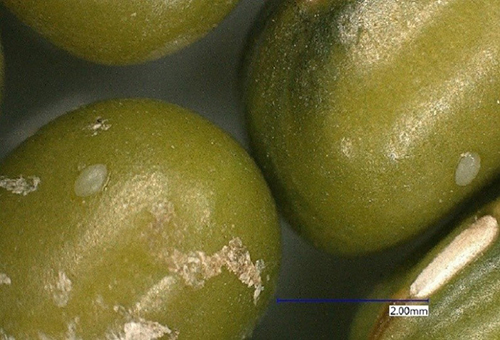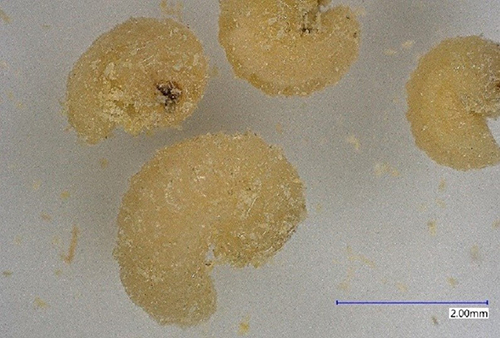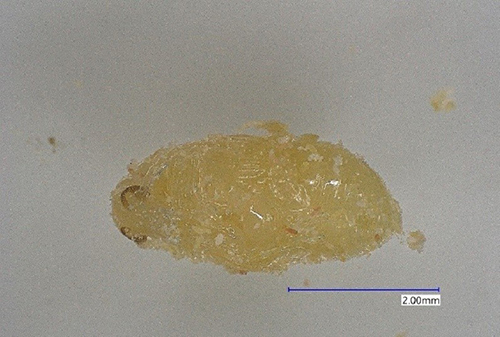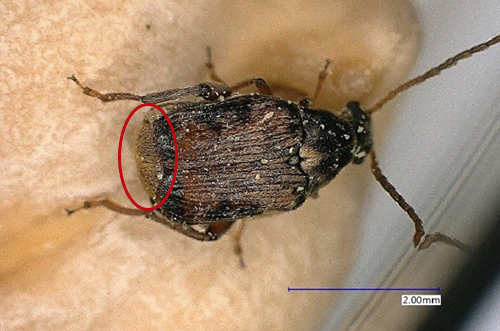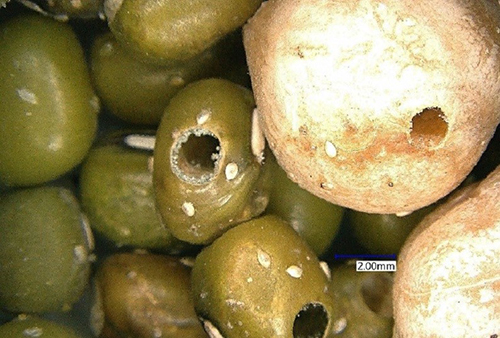common name: cowpea weevil
scientific name: Callosobruchus maculatus (Fabricius 1775) (Insecta: Coleoptera: Bruchidae)
Introduction - Distribution - Related Species - Description and Life Cycle - Economic Importance - Management - Selected References
Introduction (Back to Top)
Introduction: The cowpea weevil, Callosobruchus maculatus (Coleoptera: Bruchidae), is an important pest of legume (Fabaceae) seeds both in the field and in storage. The infestation of the crops starts in the field (Prevett, 1961), while most damage occurs during storage. Callosobruchus maculatus is the most destructive on cowpeas, Vigna unguiculata (L.), causing over 90% yield reduction (Caswell 1981). The population of Callosobruchus maculatus can grow exponentially, leading to significant loss in seed weight, germination viability, and the market value of the crop. (Caswell 1968, Singh 1977, Southgate 1979, Beck and Blumer 2014).
Fig. 1. Female Callosobruchus maculatus feeding on Mung bean (Vigna radiata) at magnification 50X. Photograph by Garima Garima, Department of Entomology and Nematology. University.
Distribution (Back to Top)
Callosobruchus maculatus is a cosmopolitan pest. Biogeographically, the species originated in Africa. It later spread to tropical and sub-tropical parts of the world (Beck and Blumer 2014).
Related Species (Back to Top)
There are 20 species in the genus Callosobruchus i.e. C. analis,C. chinensis, C. dolichosi, C.imitator, C. latealbus, C. nigripennis, C. phaseoli, C. pilcher, C. rhodesianus, C. semigriseus, C. subinnotatus, C. theobromae, C. utidai. (Tuda et al. 2006). They are all considered economically important on legumes.
Description and Life Cycle(Back to Top)
Callosobruchus maculatus is a holometabolic insect with life stages including egg, larva, pupa, and adult.
Callobruchus maculatus adults are polymorphic with two morphs, i.e., a sedentary or flightless morph and a flight or dispersal morph. The life history of both morphs is different with regard to their morphology, physiology, and behavior. The lifespan of the sedentary morph is shorter, and the fecundity is higher than the dispersal morph. The male and female are more easily distinguished in sedentary morph than dispersal morph. High larval density inside the seed, increased temperature, bean host's water content, and photoperiod lead to the flight morph formation (Utida 1972, Beck and Blumer 2014).
The most critical variables influencing the generation time from egg to adult are temperature and relative humidity while rearing Callosobruchus maculatus on the preferred host (Howe and Currie 1964, Schoof 1941). The increase in temperature can decrease generation time. Callosobruchus maculatus can complete one generation within 3-4 weeks at 30°C and average relative humidity of 30% in the laboratory (Beck and Blumer 2014).
Generation time also depends on the species of legume. The generation time on mung beans (Vigna radiata) and black-eyed peas (Vigna unguiculata subsp. unguiculata) is 3-4 weeks compared to adzuki beans (Vigna angularis), where it takes seven weeks at 30°C. (Beck and Blumer 2014).
Eggs: A single female Callosobruchus maculatus lays more than 100 eggs during its lifetime and deposits one egg per seed. Eggs are transparent, oval, or spindle-shaped (Fig. 2) and glued to the seed surface (Beck and Blumer 2014). These are small, 0.74 mm in length, and 0.38 mm in width at 50X. Mitchell (1975) suggested that the female bean beetle's life cycle duration increases if the female lays multiple eggs on each seed.
Figure 2: Eggs of Callosobruchus maculatus. (Pointed by yellow arrow) at magnification 50X. Photograph by Garima Garima, Department of Entomology and Nematology. University of Florida.
Larva: The egg hatches, and the larva (whitish color; Fig. 3) bores inside the seed. Once the larva gets inside, the eggshell turns opaque as it gets filled with the larval frass (Devereau et al. 2003). It has four larval instars before turning into the pupa.
Figure 3: Larva of Callosobruchus maculatus at magnification 50X. Photograph by Garima Garima, Department of Entomology and Nematology, University of Florida.
Pupa: The pupa is whitish, about 3.87 mm long and 1.76 mm wide at 50X (Fig.4). When the larva starts to pupate, the seed's shell starts turning thinner (Beck and Blumer 2014).
Figure 4: Pupa of Callosobruchus maculatus at magnification 50X. Photograph by Garima Garima, Department of Entomology and Nematology, University of Florida.
Adult: The adult Callosobruchus maculatus chews the seed coat and emerges out of the seed. The adult is metallic in color with some pale spots/stripes. The head of the male and female is black, and the wings are brown with black patches. The male (Fig. 5) and female (Fig. 6) can be distinguished by the plate's color at the abdomen's end. In the female, the plate is large and colored black on the sides with a white longitudinal line, while in the male, it is smaller and lacks strips. The adults become sexually mature after 24- 48 hours of emergence. The adult lives for two-three weeks. (Beck and Blumer 2014).
Male Callosobruchus maculatus beetles have spines in genital organs, and they tend to puncture females' genital tract during copulation (Edvardsson and Tregenza 2005). Males and females are both polygamous. Female Callosobruchus maculatus mating with multiple virgin males live longer, lay more and larger sized eggs throughout life (Wasserman and Asami 1985, Fox 1993) than females mating only once. The number of eggs laid by the female depends on the hosts' availability to decrease the larval competition (Credland 1986, Messina and Slade 1999).
Figure 5: Male Callosobruchus maculatus, red circle is showing the abdominal plate at magnification 50X. Photograph by Garima Garima, Department of Entomology and Nematology, University of Florida.
Figure 6: Female Callosobruchus maculatus, red circle is showing the abdominal plate at magnification 50X. Photograph by Garima Garima, Department of Entomology and Nematology, University of Florida
Economic Importance(Back to Top)
Callosobruchus maculatus is a serious economic pest of stored legumes and seed infestation starts in the field. Feeding injury by the developing Callosobruchus maculatus larvae reduces the amounts of carbohydrates and proteins of the grain, leading to the degradation of the nutritional quality and forcing the growers to sell their commodity with low economic value after harvest (Allotey and Oyewo 1993, Murdock et al. 2003). It is estimated that the economic losses caused due to Callosobruchus maculatus infestation in stored grain legumes are 35%, 7-13%, and 73% in Central America, South America, and Kenya, respectively (Nahdy 1994 and Hu et al. 2009). Legume seeds stored for six months can experience 70% seed infestation and about 30% yield loss, leaving them unacceptable for human consumption (Singh and Jackai 1985). However, there is not enough information about the economic injury level (EIL) of Callosobruchus maculatus under storage conditions (Hamdi et al. 2017). Callosobruchus maculatus is used for rearing biocontrol agents such as the hymenopteran Catolaccus hunteri of pepper weevil (Anthonomus eugenii). (Vásquez et al. 2005).
Figure 7: Damage of Callosobruchus maculatus at magnification 20X. Photograph by Garima Garima, Department of Entomology and Nematology, University of Florida
Management (Back to Top)
Chemical control: Environmental risk and development of resistant traits leave the synthetic insecticides inconvenient for managing stored grain pests like Callosobruchus maculatus (Odeyemi et al. 2006). Different botanical extracts exhibited the insecticidal activity on Callosobruchus maculatus (Sanon et al. 2010). Rahman and Talukder (2006) reported that the powdered leaves extract of nishinda (Vitex negundo L.), eucalyptus (Eucalyptus globules Labill.), and bankalmi (Ipomoea sepiaria K.) were blended with black gram seeds at a rate of 3% mixture (w/w) had reduced insect oviposition, adult emergence and infestation rate. They also found the bablah (Acacia arabica L.) ash is more effective than the powdered leaves of nishinda, eucalyptus, and bankalmi. Treated seeds with plant oils of mustard, safflower, castor, coconut, cotton, groundnut, and soybean provided surface protection from Callosobruchus maculatus infestation by reducing the seed damage rate and the number of emerged adults (Ketker 1989, Shaaya et al. 1997, Ahmed et al. 1999). Ilboudo et al. (2010) reported higher mortality of adult Callosobruchus maculatus with the essential oils extracted from Ocimum amricanum, Hyptis suaveolens, Hyptis spicigera and Lippia multiflora. The seed storage jute bags for cowpea seeds treated with plant leaf extracts of A. indica, V. negundo, C. collinus, and J. curcas reduced egg-laying rate, adult emergence and seed infestation by Callosobruchus maculatus (Raja et al. 2000). Several research findings suggested that botanical extract oil treatment did not reduce the seed quality and germination rate (Das 1986, Onu and Aliyu 1995, Keita et al. 2001).
More than 60% of the newly emerged adult mortality has been recorded by exposing them to essential oils from sweet basil, Ocimum basilicum, and African basil, O. gratissimum, (Labiatae) in Guinea (Kéita 2001). The essential oil extracted from Mentha piperita and Salvia officianalis result in 100% mortality (Fabricius 2010). Cashew kernel extracted from the water was also toxic to Callosobruchus maculatus (Adedire et al. 2011). Seeds treated with clove and black pepper showed effectiveness against cowpea weevil (Mahdi and Rahman 2008). Seeds treated with neem (Azadirachta indica) extract proves effective in repelling cowpea weevil (Elhag 2000).
Biological control: Hymenopteran ectoparasitoids i.e. Uscana lariophaga (Steffan), Dinarmus basalis (Rondani), and Eupelmus vuilleti (Crawford) are promising biocontrol agents for Callosobruchus maculatus (Monge and Huignard 1991, Sanon et al. 1998). A higher Callosobruchus maculatus mortality can be achieved by releasing the ectoparasitoid D. basalis combined with essential oil extracted from Cymbopogon schoenanthus. However, the oil should be applied before releasing the parasitoid. Parasitoid adults are also susceptible to oil (Ketoh et al. 2005).
Entomopathogenic fungi (Beauvarin®) effectively reduced the population of Callosobruchus maculatus in stored cowpea and wheat (Shams et al. 2011). Bacillus thurigiensis (at 4x 108 cells/ml) can target the larval and pupal stages and result in 100% mortality of Callosobruchus maculatus (Malaikozhundan and Vinodhini 2018).(Malaikozhundan and Vinodhini 2018).
Sterile insect technique (SIT) and autocidal control methods effectively manage stored grain pests (Bakri et al. 2005, Fetoh 2011). Ionizing radiation (gamma rays, cobalt-60 source) between 50 and 100 Gy can prevent the development of all stages of Callosobruchus maculatus (Diop et al. 1997, Bhalla et al. 2008). The use of gamma-irradiated sub sterilized males in over flooding ratio can stop the multiplication of been beetle. The application of a low dose of 20 Gy can induce semi-sterility in adults of Callosobruchus maculatus (Ibrahim et al. 2017).
Physical control: Freezing the whole storage area for a long time can control Callosobruchus maculatus (Johnson and Valero 2000). Also, lowering the temperature to 10°C can effectively reduce the beetle's infestation as development ceases below 12°C.
The high temperature and low humidity or solar heating effectively inhibit egg-laying, embryonic development of Callosobruchus maculatus causing mortality of the emerging adults (Murdock et al. 1991, Adebayo and Anjorin 2018). Barbosa et al. (2017) found the microwave radiation (240 W microwave power level at frequency 2450 MHz for 120 and 150 s) was lethal to Callosobruchus maculatus. They also found reducing emerging adults and increased developmental period (egg - adult) with the increased microwave exposure (30, 60, 90, 120, and 150 s). Loganathan et al. (2011) reported the lethal time for eggs, larvae, pupae, and adults at 42°C were 18, 57, 78, and 71 h respectively and at 0° were 3, 8, 10, and 4 days. The low temperature (-14±1°C) effectively controls all developmental stages, including adults (Bhalla et al. 2008).
Light spectra are an important source to reduce the damage caused by Callosobruchus maculatus. Kehinde et al. (2019) reported that the highest mortality of Callosobruchus maculatus under white light while red and blue lights are also lethal by using electric bulbs at 25 Watts. Pandiselvam et al. (2018) revealed increased mortality of different life stages of Callosobruchus maculatus with the high gaseous ozone concentration and exposure time when exposed to 500-1500 ppmv ozone.
Storage of the cowpea grain in the sealed metal drum (Seek and Gasper 1992) and the use of triple plastic bagging provided effective control over Callosobruchus maculatus infestation. Within these sealed environments, the developmental stages of Callosobruchus maculatus are impacted by the depletion of oxygen and the elevation of carbon dioxide (Seek et al. 1996). Modified storage environment by increasing carbon dioxide (CO2) levels (hypercarbia) and decreasing oxygen (O2) levels (anoxia), and lowering the humidity significantly affected Callosobruchus maculatus with high egg and adult mortality (Navarro and Calderon 1980, Ofuya and Reichmuth 2002).
Cultural control: Callosobruchus maculatus is unable to infest the legume pods with hairy and thick walls. The genetically modified adzuki beans producing amylase inhibitors (alphaAL), making them resistant to Callosobruchus maculatus attack (Ishimoto et al. 1996). The cowpea varieties with trypsin inhibitors (Shade et al. 1996), tannins (Oigiangbe and Onigbinde 1996), chitinases and beta -1,3-glucanases (Gomes et al. 1996) and insecticidal lectins (Murdock et al. 1990, Zhu et al. 1996, Omitogun et al. 1999) are resistant to Callosobruchus maculatus infestation.
Selected References (Back to Top)
- Adebayo, R. A., and O. O. Anjorin. 2018. Assessment of entomocidal effects of solar radiation for the management of cowpea seed beetle, Callosobruchus maculatus (F.) (Coleoptera: Chrysomelidae) in stored cowpea. Global Journal of Science Frontier Research, 18: 21-26.
- Adedire, C. O., O. M. Obembe, R. O. Akinkurolere, and S. O. Oduleye. 2011. Response of Callosobruchus maculatus (Coleoptera: Chrysomelidae: Bruchinae) to extracts of cashew kernels. J PLANT DIS PROTECT .118(2): 75-79.
- Ahmed, K.S., T, Itino, and T. Ichikawa. 1999. Effects of plant oils on oviposition preference and larval survivorship of Callosobruchus chinensis (Coleoptera: Bruchidae) on azuki bean. Applied Entomology and Zoology 34(4):.547-550.
- Allotey, J., and A. Oyewo. 1993. Some aspects of the biology and control of Callosobruchus maculatus (F.) on some stored soybean, Glycine max (L.) Merr, varieties under tropical conditions. Proceedings of Ghana Science Association 26: 14-18.
- Barbosa, D.R.E.S., L. da Silva Fontes, P. R. R. Silva, J. A. Neves, A. F. de Melo, and A. B. Esteves Filho. 2017. Microwave radiation to control Callosobruchus maculatus (Coleoptera: Chrysomelidae) larvae in cowpea cultivars. Austral Entomology, 56(1): 70-74.
- Bakri, A., K. Mehta, and D. R. Lance. 2005. Sterilizing insects with ionizing radiation. In Sterile Insect Technique (pp. 233-268). Springer, Dordrecht.
- Beck, C. W., and L. S. Blumer. 2014. A handbook on bean beetles, Callosobruchus maculatus.
- Bhalla, S., K. Gupta, B. Lal, M. L. Kapur, and R. K. Khetarpal. 2008, Efficacy of various non-chemical methods against pulse beetle, Callosobruchus maculatus (Fab.). In Endure International Conference (12-15 October) on Diversifying Crop Protection, La Grande Motte. France (pp. 1-4).
- Caswell G. H. 1968. The storage of cowpea in the northern states of Nigeria Proc. agric. Soc. Nigeria 5: 4-6
- Caswell, G. H., 1981. Damage to stored cowpea in the northern part of Nigeria. Samaru J. Agric. Res. 1: 11-19.
- Credland, P.F., K. M. Dick, and A. W. Wright, 1986. Relationships between larval density, adult size and egg production in the cowpea seed beetle, Callosobruchus maculatus. Ecological Entomol 11(1): 41-50.
- Das, G. P., 1986. Pesticides efficacy of some indigenous plant oils against pulse beetle, Callosobruchus chinensis L. Bangladesh Journal of Zoology, 14(1), pp.15-18.
- Devereau, A.D., I. Gudrups, J.H. Appleby, and P.F. Credland. 2003. Automatic, rapid screening of seed resistance in cowpea, Vigna unguiculata (L.) Walpers, to the seed beetle Callosobruchus maculatus (F.) (Coleoptera: Bruchidae) using acoustic monitoring. Journal of Stored Products Research 39(1):117-129.
- Diop, Y. M., E. Marchioni, D. Ba, and C. Hasselmann. 1997. Radiation disinfestation of cowpea seeds contaminated by Callosobruchus maculatus. Journal of Food Processing and Preservation, 21(1):.69-81.
- Edvardsson, M., and T. Tregenza. 2005. Why do male Callosobruchus maculatus harm their mates?. Behav Ecol. 16(4):788-793.
- Elhag, E. A. 2000. Deterrent effects of some botanical products on oviposition of the cowpea bruchid Callosobruchus maculatus (F.)(Coleoptera: Bruchidae). Int J Pest Manage. 46(2) :109-113.
- Fabricius, C. 2010. Biological activity of ten essential oils against cowpea beetle, Callosobruchus maculatus Fabricius (Coleoptera: Bruchidae). Int. J. Integr. Biol.10(2):86.
- Fetoh, B.E.A. 2011. Latent effects of gamma radiation on certain biological aspects of the red palm weevil (Rhynchophorus ferrugineus Olivier) as a new control technology. J Agric Technol, 7(4): 1169-1175.
- Fox, C. W. 1993. Multiple mating, lifetime fecundity and female mortality of the bruchid beetle, Callosobruchus maculatus (Coleoptera: Bruchidae). Functional Ecology 7, pp.203-208.
- Gomes, V. M., A. E. A. Oliveira, and J. Xavier-Filho. 1996. A Chitinase and a ß-1, 3-Glucanase Isolated from the Seeds of Cowpea (Vigna unguiculataL Walp) Inhibit the Growth of Fungi and Insect Pests of the Seed. Journal of the Science of Food and Agriculture 72(1): 86-90.
- Hamdi, S. H., S. Abidi, D. Sfayhi, M. Z. Dhraief, M. Amri, E. Boushih, M. Hedjal-Chebheb, K. M. Larbi, and J. M. B. Jemâa. 2017. Nutritional alterations and damages to stored chickpea in relation with the pest status of Callosobruchus maculatus (Chrysomelidae). Journal of Asia-Pacific Entomology, 20(4): 1067-1076.
- Howe, R.W. and J.E. Currie. 1964. Some laboratory observations on the rates of development, mortality and oviposition of several species of Bruchidae breeding in stored pulses. Bulletin of Entomological Research. 55(3):437-477.
- Hu, F., G. N. Zhang, and J. J. Wang. 2009. Scanning electron microscopy studies of antennal sensilla of bruchid beetles, Callosobruchus chinensis (L.) and Callosobruchus maculatus (F.)(Coleoptera: Bruchidae). Micron, 40(3):320-326.
- Ibrahim, H. A., S. Fawki, M. M. Abd El-Bar, M.A. Abdou, D. M. Mahmoud and E. G. E. El-Gohary. 2017. Inherited influence of low dose gamma radiation on the reproductive potential and spermiogenesis of the cowpea weevil, Callosobruchus maculatus (F) (Coleoptera: Chrysomelidae). J RADIAT RES APPL SC 10(4):338-347.
- Ilboudo, Z., L. C. B. Dabiré, R. C. H. Nébié, I. O. Dicko, S. Dugravot, A. M. Cortesero, and A. Sanon. 2010. Biological activity and persistence of four essential oils towards the main pest of stored cowpeas, Callosobruchus maculatus (F.) (Coleoptera: Bruchidae). Journal of Stored Products Research, 46(2): 124-128.
- Ishimoto, M., T. Sato, M. J. Chrispeels, and K. Kitamura. 1996. Bruchid resistance of transgenic azuki bean expressing seed α-amylase inhibitor of common bean. Entomologia experimentalis et applicata, 79(3): 309-315.
- Johnson, J. A., and K. A. Valero, 2000. Control of cowpea weevil, Callosobruchus maculatus, using freezing temperatures.
- Kéita, S. M., C. Vincent, J. P. Schmit, J. T. Arnason, and A. Bélanger. 2001. Efficacy of essential oil of Ocimum basilicum L. and O. gratissimum L. applied as an insecticidal fumigant and powder to control Callosobruchus maculatus (Fab.) Coleoptera: Bruchidae.W J. Stored Prod. Res. 37(4): 339-349.
- Kehinde, F.O., G. A. Dedeke, O. I. Popoola, and P. O. Isibor. 2019. Potential of Light Spectra as a Control of Cowpea Weevil, Callosobruchus maculatus, Activity. IOP Conference Series: Earth and Environmental Science, Volume 210, 8th International Biotechnology Conference, Exhibition and Workshop11-13 March 2018, Nigeria.
- Ketker, C. M. 1989. Use of tree derived non-edible oils as surface protectants for stored legumes against Callosobruchus maculatus and Callosobruchus chinensis. Rev. Appl. Entomol., 77 (8): 659.
- Ketoh, G. K., H. K. Koumaglo, and I. A. Glitho. 2005. Inhibition of Callosobruchus maculatus (F.)(Coleoptera: Bruchidae) development with essential oil extracted from Cymbopogon schoenanthus L. Spreng.(Poaceae), and the wasp Dinarmus basalis (Rondani) (Hymenoptera: Pteromalidae). J. Stored Prod. Res. 41(4): 363-371.
- Mahdi, S. H. A., and M. K. Rahman. 2008. Insecticidal effect of some spices on Callosobruchus maculatus (Fabricius) in black gram seeds. University journal of zoology, Rajshahi University. 27:47-50.
- Malaikozhundan, B., and J. Vinodhini. 2018. Biological control of the Pulse beetle, Callosobruchus maculatus in stored grains using the entomopathogenic bacteria, Bacillus thuringiensis. Microbial pathogenesis 114: 139-146.
- Messina, F. J., and A. F. Slade. 1999. Expression of a life-history trade-off in a seed beetle depends on environmental context. Physiological Entomol. 24(4): 358-363.
- Mitchell, R. 1975. The evolution of oviposition tactics in the bean weevil, Callosobruchus maculatus (F.). Ecology. 56(3):696-702.
- Monge, J. P., and J. Huignard. 1991. Population fluctuation of two bruchid species Callosobruchus maculatus F. and Bruchidius atrolineatus Pic (Coleoptera: Bruchidae) and their parasitoids Dinarmus basalis Rondani and Eupelmus vuilleti Crawford (Hymenoptera: Pteromalidae: Eupelimidae) in a storage condition in Niger. Journal of African Zoology, 105: 197-206.
- Muimba-Kankolongo, A. 2018. Food Crop Production by Smallholder Farmers in Southern Africa: Challenges and Opportunities for Improvement. Academic Press.
- Murdock, L. L., D. Seck, G. Ntoukam, L. Kitch, and R. E. Shade. 2003. Preservation of cowpea grain in sub-Saharan Africa- Bean/Cowpea CRSP contributions. Field Crop Research 82 (2- 3):169-178. DOI: https://doi.org/10.1016/S0378-4290(03)00036-4
- Murdock, L. L., J. E. Huesing, S. S. Nielsen, R. C. Pratt, and R. E. Shade. 1990. Biological effects of plant lectins on the cowpea weevil. Phytochemistry, 29(1): 85-89.
- Nahdy, M. S. 1994. Bean sieving, a possible control measure for the dried bean beetles, Acanthoscelides obtectus (Say)(Coleoptera: Bruchidae). J. Stored Prod. Res. 30(1):65-69.
- Navarro, S., and M. Calderon. 1980. Integrated approach to the use of controlled atmospheres for insect control in grain storage. In Controlled atmosphere storage of grains (pp. 73-78). Elsevier Amsterdam.
- Odeyemi, O. O., O. A. Gbaye, and O. Akeju. 2006, Resistance of Callosobruchus maculatus (Fab.) to pirimiphos methyl in three zones in Nigeria. In 9th International Working Conference on Stored Product Protection pp. 15-18.
- Ofuya, T. I. and C. Reichmuth. 2002. Effect of relative humidity on the susceptibility of Callosobruchus maculatus (Fabricius)(Coleoptera: Bruchidae) to two modified atmospheres. Journal of Stored Products Research, 38(2): 139-146.
- Omitogun, O. G., L. E. N. Jackai, and G. Thottappilly. 1999. Isolation of insecticidal lectin-enriched extracts from African yam bean (Sphenostylis stenocarpa) and other legume species. Entomologia Experimentalis et Applicata, 90(3): 301-311.
- Onu, I. and M. Aliyu. 1995. Evaluation of powdered fruits of four peppers (Capsicum spp.) for the control of Callosobruchus maculatus (F) on stored cowpea seed. International Journal of Pest Management, 41(3): 143-145.
- Pandiselvam, R., V. Thirupathi, S. Mohan, P. Vennila, D. Uma, S. Shahir, and S. Anandakumar, 2019. Gaseous ozone: A potent pest management strategy to control Callosobruchus maculatus (Coleoptera: Bruchidae) infesting green gram. Journal of Applied Entomology, 143(4:451-459.
- Prevett, P.F., 1961. Field infestation of cowpea (Vigna unguiculata) pods by beetles of the families Bruchidae and Curculionidae in Northern Nigeria. Bulletin of Entomological research, 52(4): 635-645.
- Rahman, A., and F. A. Talukder. 2006. Bioefficacy of some plant derivatives that protect grain against the pulse beetle, Callosobruchus maculatus. J. Insect Sci. 6 (1).
- Raja, N., A. Babu, S. Dorn, and S. Ignacimuthu. 2001. Potential of plants for protecting stored pulses from Callosobruchus maculatus (Coleoptera: Bruchidae) infestation. Biological agriculture & horticulture 19(1):19-27.
- Sanon, A., A. P. Ouedraogo, Y. Tricault, P. E. Credland, and J. Huignard. 1998. Biological control of bruchids in cowpea stores by release of Dinarmus basalis (Hymenoptera: Pteromalidae) adults. Environmental entomology, 27(3), pp.717-725.
- Sanon, A., N. M. Ba, C. L. Binso-Dabire, and B. R. Pittendrigh. 2010. Effectiveness of Spinosad (Naturalytes) in controlling the cowpea storage pest, Callosobruchus maculatus (Coleoptera: Bruchidae). J Econ. Entomol. 103(1):203-210.
- Schoof, H.F. 1941. The effects of various relative humidities on the life proceses of the southern cowpea weevil, Callosobruchus maculatus (Fabr.) at 30 C., +/- 0.8 degrees. Ecology 22(3):297-305.
- Seek, D., G. Lognay, M. Haubruge Marlier, and C. Gasper. 1996. Alternative protection of cowpea seeds against Callosobruchus maculatus using hermetic storage alone or in combination with Boscia senegalensis (Pers.) Lam ex Poir. J. Stored Prod. Res.32 (1): 39-44.
- Shade, R. E., L. W. Kitch, P. Mentzer, and L. L. Murdock. 1996. Selection of a cowpea weevil (Coleoptera: Bruchidae) biotype virulent to cowpea weevil resistant landrace TVu2027. J. Econ. Entomol. 89: 1325Ð1331.
- Shams, G., M. H. Safaralizadeh, S. Imani, M. Shojai, and S. Aramideh. 2011. A laboratory assessment of the potential of the entomopathogenic fungi Beauveria bassiana (Beauvarin) to control Callosobruchus maculatus (F.) (Coleoptera: Bruchidae) and Sitophilus granarius (L.) (Coleoptera: Curculionidae). African Journal of Microbiology Research, 5(10), pp.1192-1196.
- Shaaya, E., M. Kostjukovski, I. Eilberg, and C. Sukprakarn. 1997.Plant oils as fumigants and contact insecticides for the control of stored-product insects. Journal of Stored Products Research 33: 7-15.
- Singh, S. R. 1977. Cowpea cultivars resistant to insect pests in world germplasm collections.Tropical Grain Legume Bulletin 9, 3.
- Singh, R. S. and L. E.N Jackai. 1985. Insect pests of cowpeas in Africa: their life cycle, economic importance, and potential for control. In Cowpea research, production and utilization, (Eds Singh, R. S., & Rachie, K. O.). John Wiley, Chichester pp 217-231.
- Southgate, B. J. 1979. Biology of the Bruchidae. Annual review of entomology, 24(1): 449-473.
- Tanzubil, P. B. 1991. Control of some insect pests of cowpea (Vigna unguiculuta) with neem (Azadirachta indica A Juss.) in Northern Ghana. Int J Pest Manage. 37(3):216-217.
- Tuda, M., J. Rönn, S. Buranapanichpan, N. Wasano, and G. Arnqvist. 2006. Evolutionary diversification of the bean beetle genus Callosobruchus (Coleoptera: Bruchidae): traits associated with stored-product pest status. Molecular Ecology, 15(12): 3541-3551.
- Utida, S. 1972. Density dependent polymorphism in the adult of Callosobruchus maculatus (Coleoptera, Bruchidae). J. Stored Prod. Res. 8(2): 111-125.
- Vásquez, E., D. Dean, D. Schuster, and P. Van Etten. 2005. A laboratory method for rearing Catolaccus hunteri (Hymenoptera: Pteromalidae), a parasitoid of the pepper weevil (Coleoptera: Curculionidae). Fla Entomol. 88(2): 191-194.
- Wasserman, S. S. and T. Asami. 1985. The effect of maternal age upon fitness of progeny in the southern cowpea weevil, Callosobruchus maculatus. Oikos, pp.191-196.
- Zhu, K., J. E. Huesing, R. E. Shade, R. A. Bressan, P. M. Hasegawa, and L. L. Murdock. 1996. An insecticidal N-acetylglucosamine-specific lectin gene from Griffonia simplicifolia (Leguminosae). Plant physiology, 110(1): 195-202.

